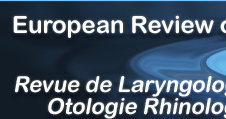 Issue N# 3 - 2009
Issue N# 3 - 2009

RHINOLOGY
The uses of computer-assisted surgical navigation in trans-nasal pituitary gland surgery
Authors : Hitier M, Hibon R, Candelier G. Guarnieri J, Moreau S, Babin E. (Caen)
Ref. : Rev Laryngol Otol Rhinol. 2009;130,3:151-157.
Article published in english 
Downloadable PDF document english 
Summary :
Objectives: To examine the use of computer-assisted surgery in transnasal pituitary gland surgery. Patients and methods: Twenty cases of transnasal pituitary gland surgery using a computer-assisted navigation system, carried out between 2002 and 2004, were retrospectively studied. The subjects consisted of 7 men and 13 women aged between 27 and 77 years of ages. The pituitary tumours included 18 macroadenomas, a microadenoma and a craniopharyngioma. Ten of the cases presented with visual field and/or visual acuity disturbances. Seven of the cases presented with endocrine disorders. A computed tomography scanner destined for navigation purposes was carried out 24 hours before the operation. The computer-assisted system used was the Digipointeur (Collin ORL) based on a system of spatial localization in electromagnetic fields. Results: Tumour removal was complete in 50% of cases and partial, as judged by MRI 3 months after the procedure, in 45% of the cases. In 40% of cases, the preoperative visual disturbances had completely disappeared at 3 months. A considerable clinical improvement was observed in all of the other cases. Peroperative complications were limited to two breaches of the meninges and one peroperative hemorrhage during the excision of a macroadenoma invading the cavernous sinus, necessitating the suspension of the operation. Conclusion: In our experience, the use of a computer-assisted system in transseptal pituitary surgery gives reliable millimetric surgical precision in the localization of vital internal anatomical structures, optimizes surgical resection and increases levels of safety.
Price : 10.50 €

|



